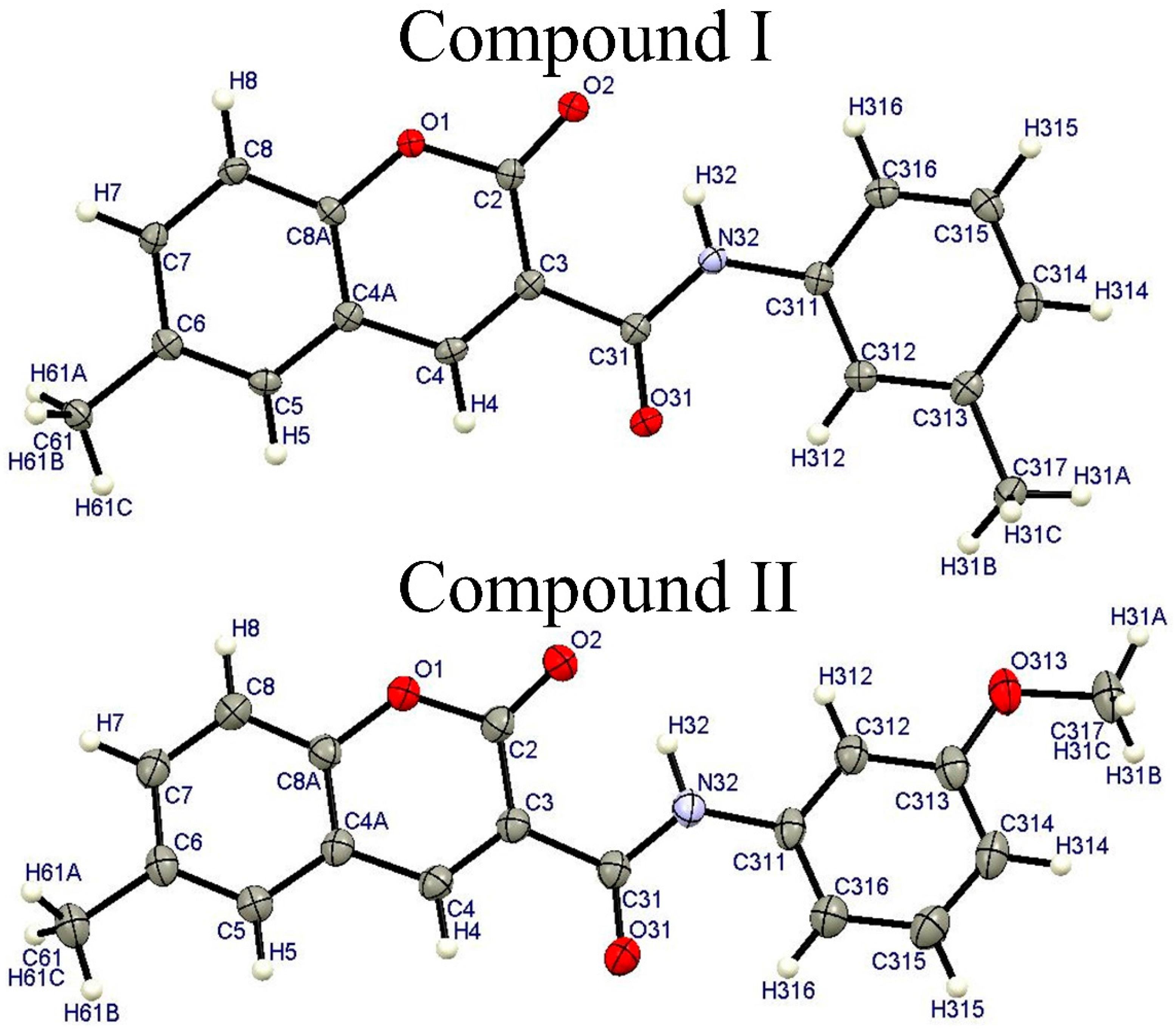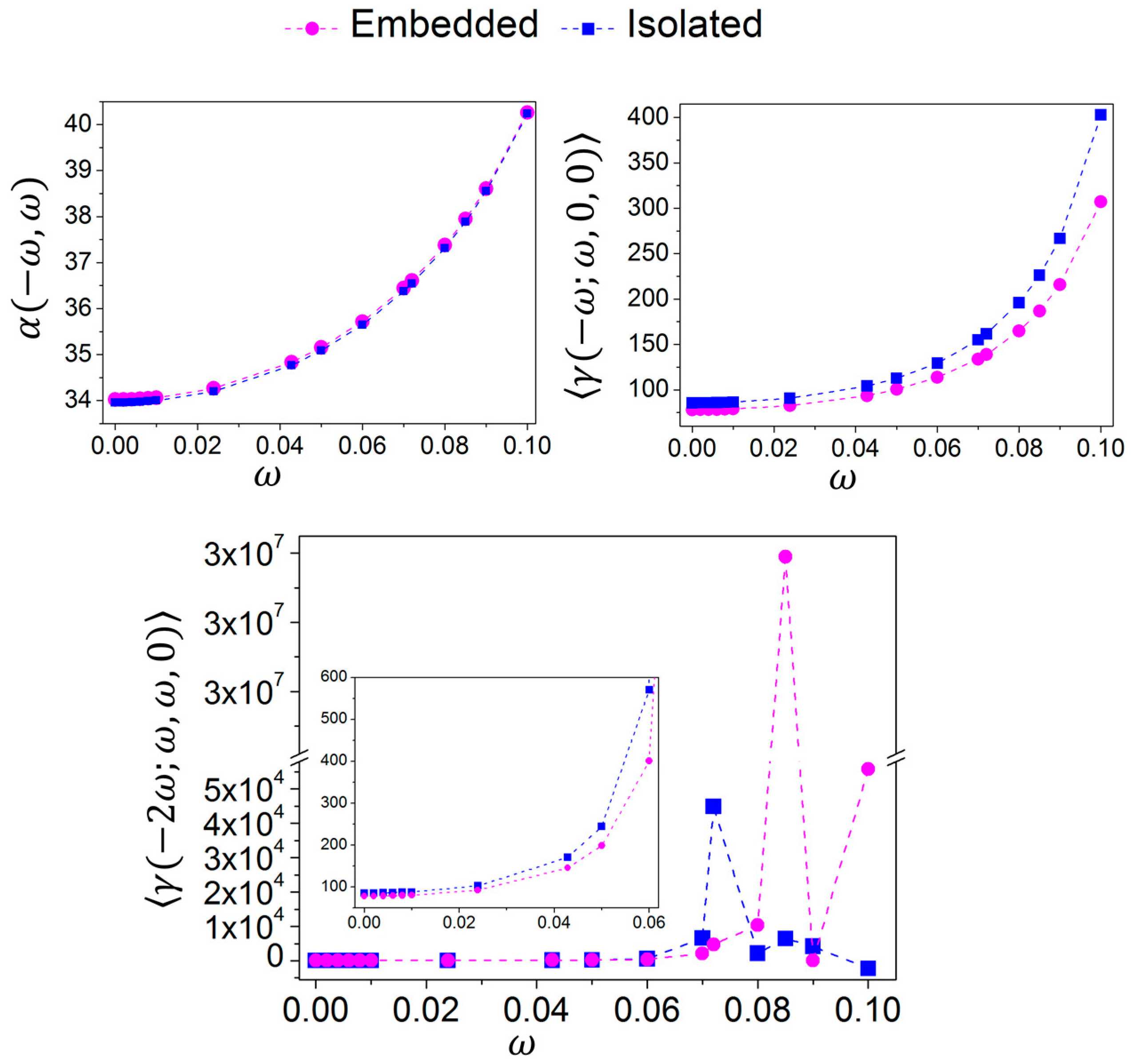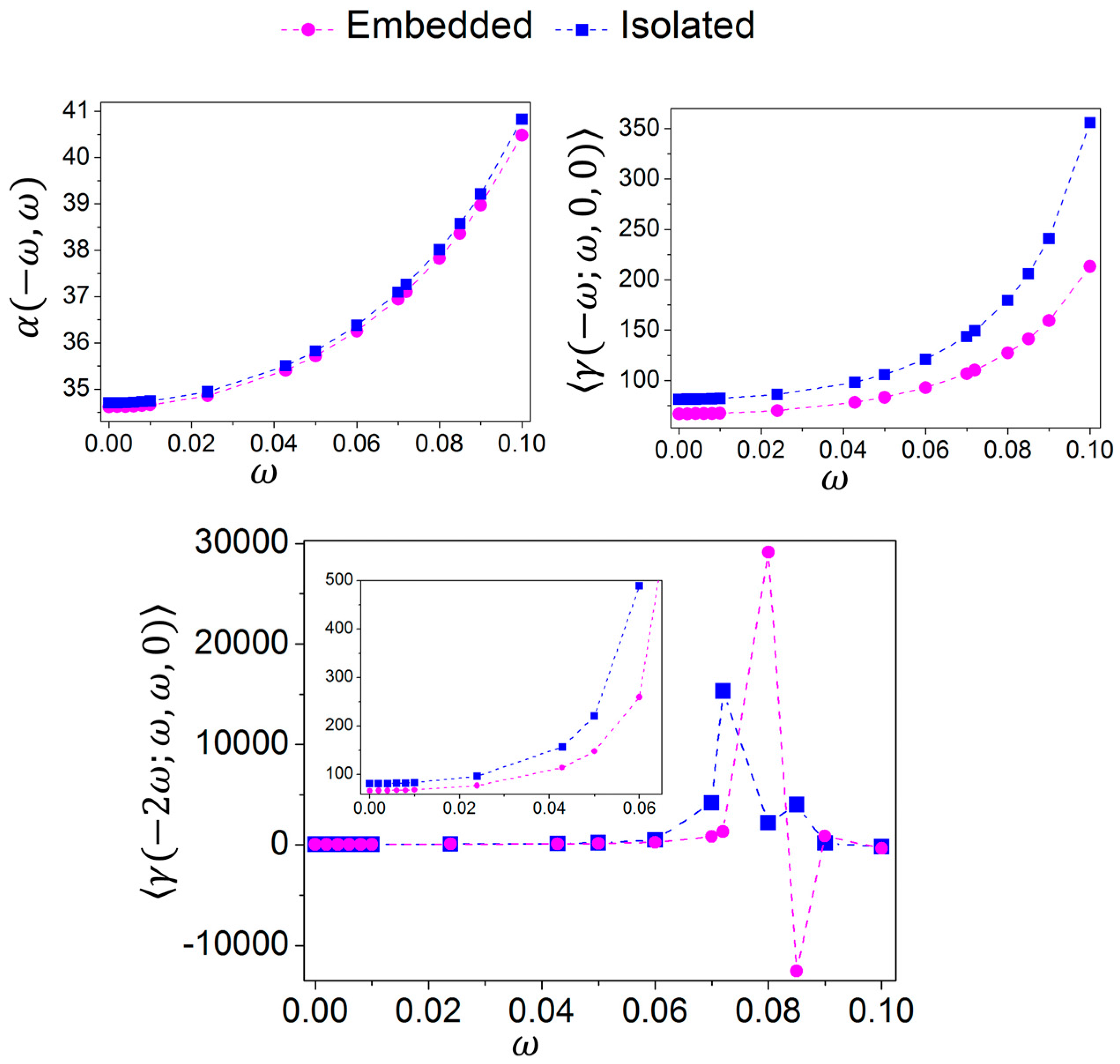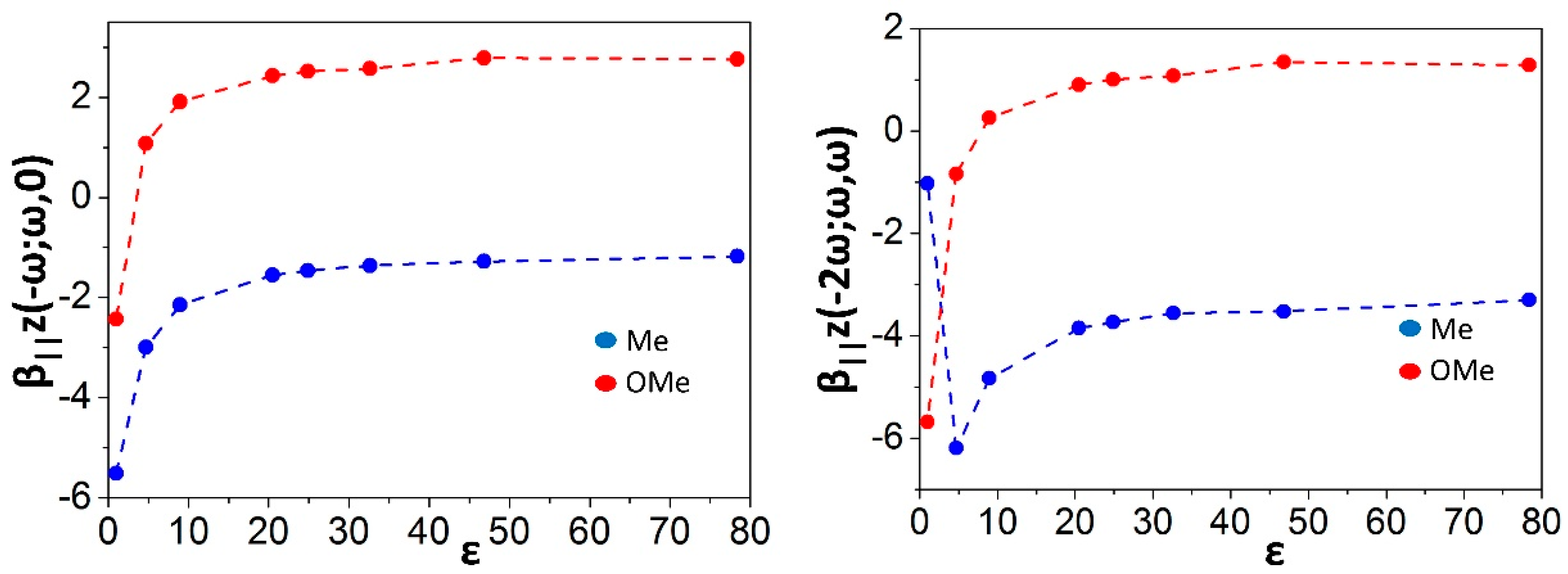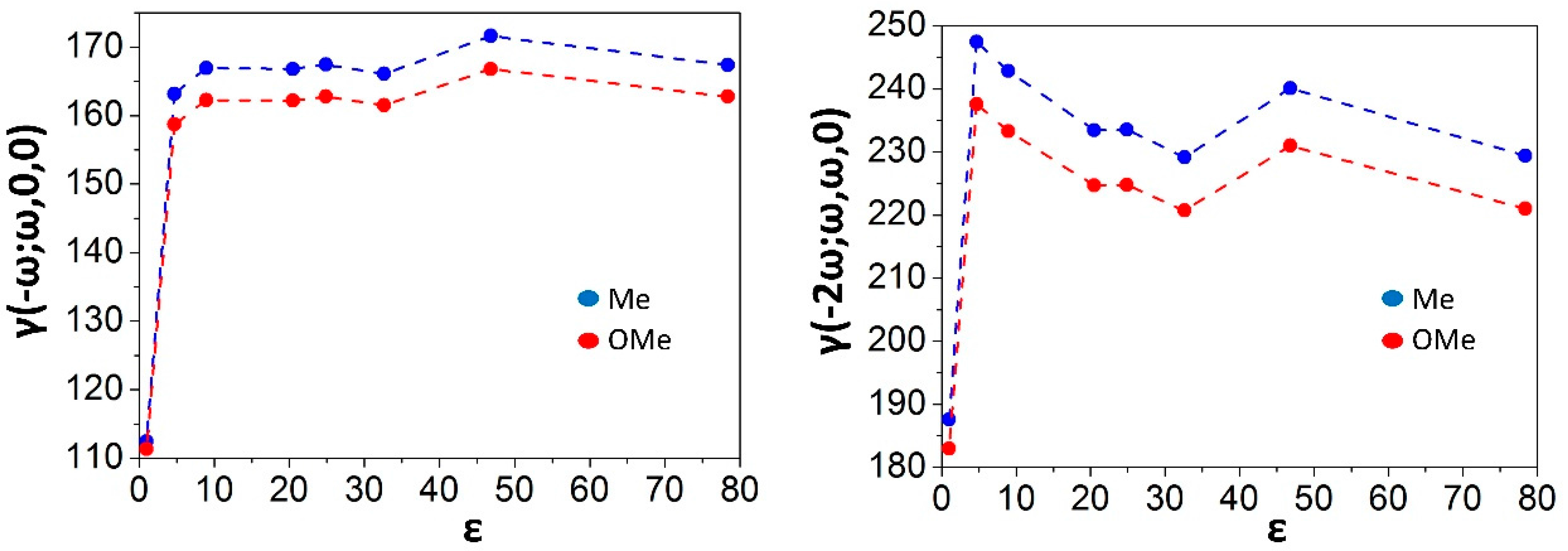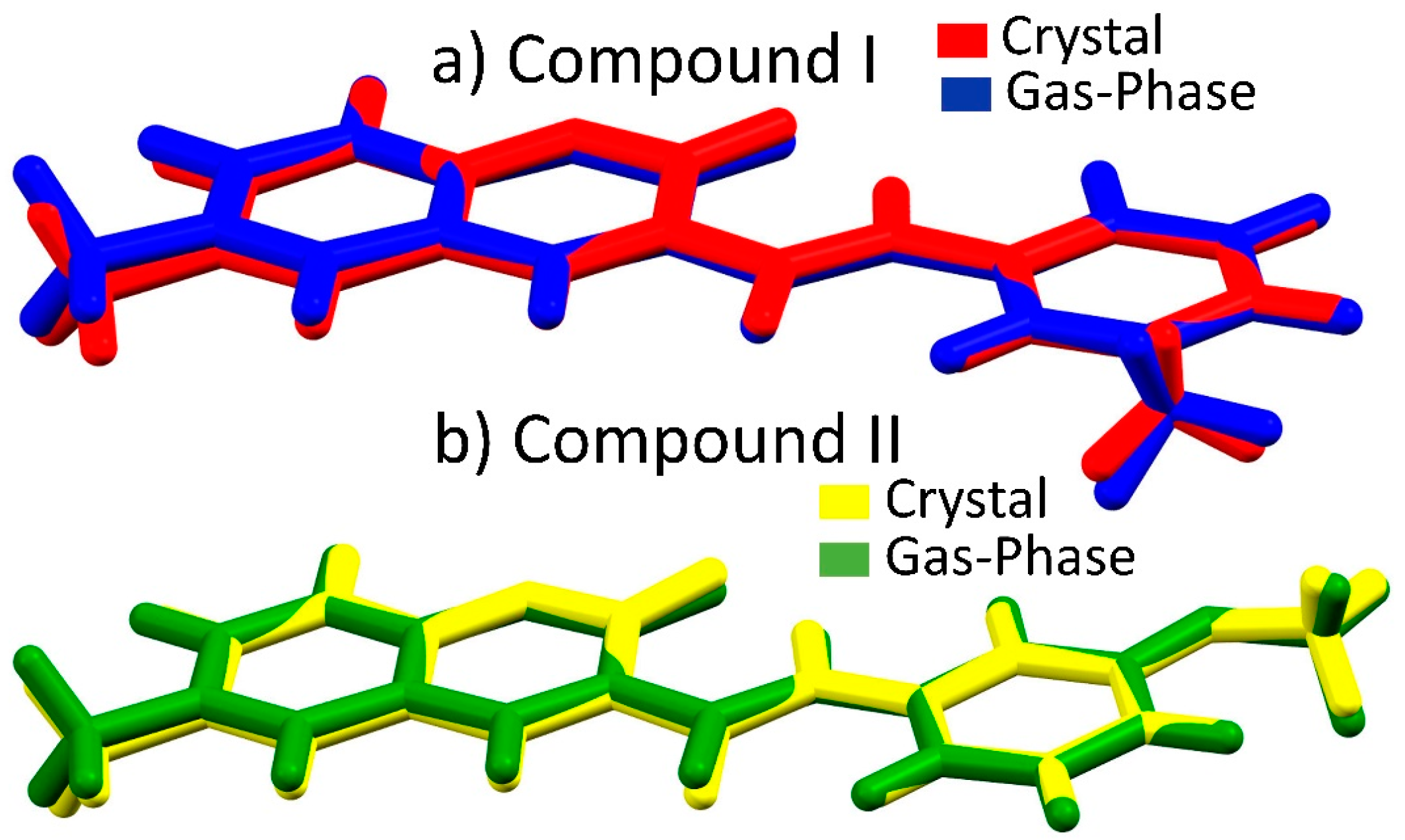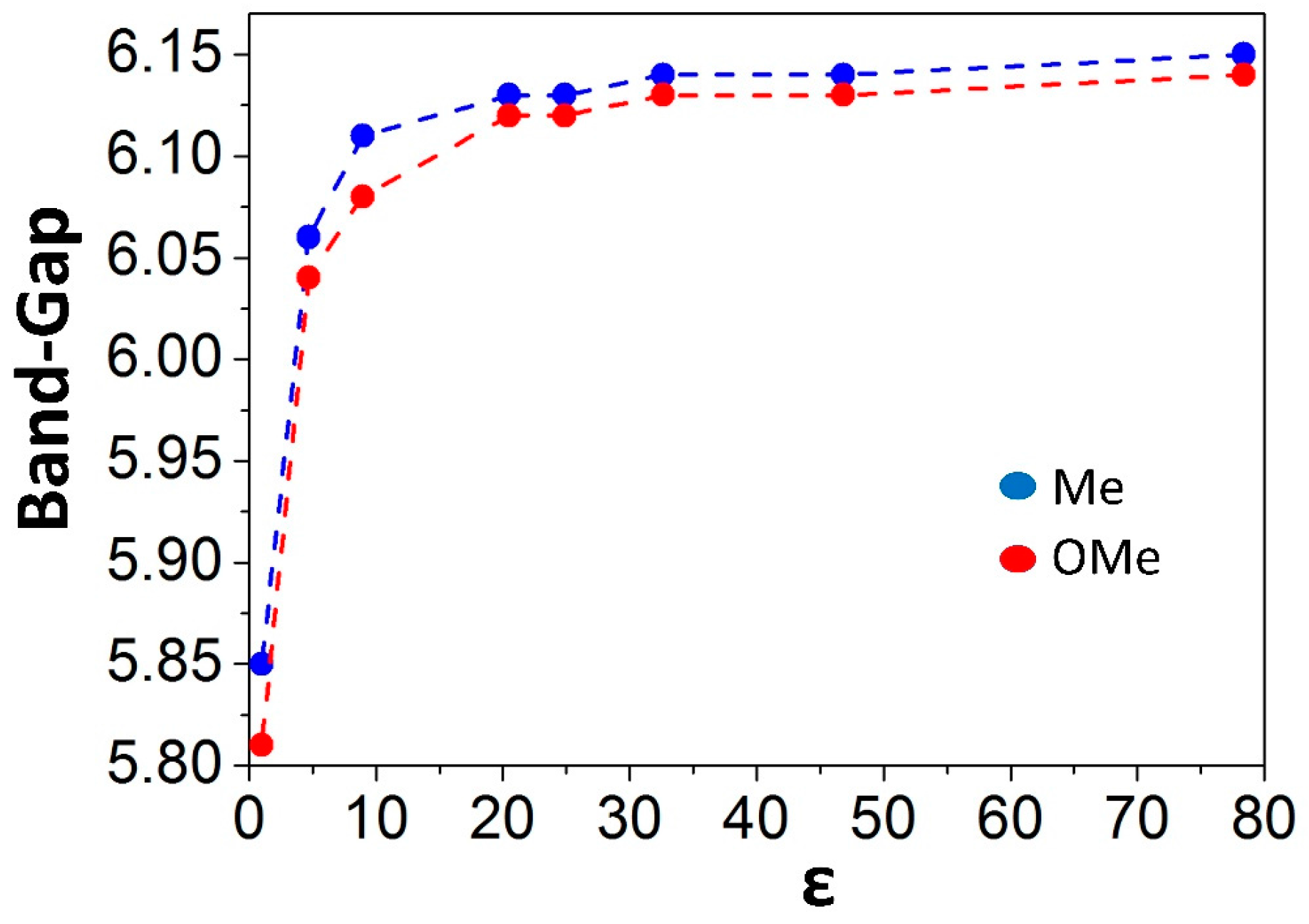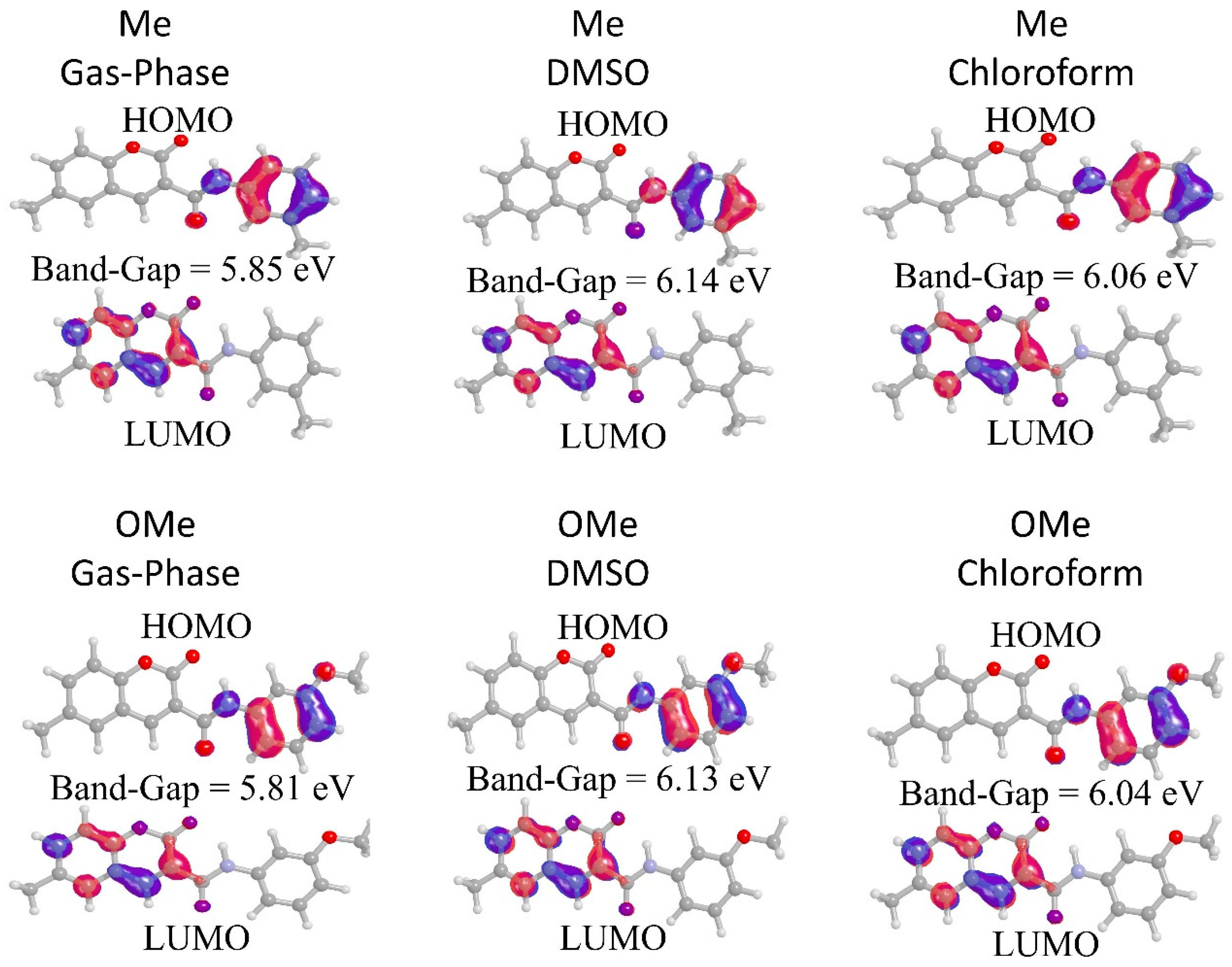1. Introduction
Coumarin and its derivatives have been investigated by several authors in the last few years due to their application in the pharmaceutical industry as a precursor reagent in the synthesis of a number of synthetic anticoagulants [
1]. Furthermore, coumarins display anticancer, antiviral, anti-inflammatory and anti-oxidant biological properties. Besides that, coumarin and its derivatives also work as well-known laser dyes [
2,
3,
4] and useful probes in different photochemical and chemical studies. Most coumarins are highly fluorescent, a property that qualifies them for several applications, e.g., as high-efficiency dye-sensitized solar cells [
5,
6,
7]. Other properties of coumarins come from an important building block, due to their synthetic accessibility and substitution variability. Also, in view of their structural diversity and potential applications in different areas of science, they play an important role in the modifications of different properties displayed by the introduction of different substituents into the heterocyclic ring.
Nonlinear optical (NLO) materials have attracted great attention due to their potential applications: among them we can cite signal processing for integrated optical applications and other sections of materials science and ultrafast optical communications [
8,
9,
10,
11]. This ultrafast response time feature enables the application of organic crystals in photonic devices [
12,
13,
14,
15,
16]. Organic materials have been exhaustively studied since their non-linear optical properties can be better than those of inorganic ones.
In this work, we investigate the NLO properties of two coumarin derivatives, 6-methyl-N-(3-methilphenyl)-2-oxo-2H-chromene-3-carboxamide (compound I) and N-(3-methoxophenyl)-6-methyl-2-oxo-2H-chromene-3-carboxamide(compound II). The difference between these two compounds stems from the type of substituent at 3-position of the pendant benzene ring (see
Figure 1). Our goal is the study of the effect caused by the change of coumarin substituents on the electric properties of the compounds I (
) and compound II (
). To this end, we calculate the dipole moment, the linear polarizability and the second hyperpolarizability for the isolated and embedded molecules of these two coumarins in the static and dynamic conditions. The molecular hyperpolarizabilities govern the behavior of the NLO process, such as the second harmonic generation, electro-optical effects and third harmonic generation. These processes have many applications, e.g., optical processing of information and optical computing, having great interest for state-of-the-art technology.
We will also consider the solvent media effect on the NLO dynamic properties of these compounds (Second Harmonic Generation (SHG), Kerr effect, dc-SHG) and, for this purpose, we calculate the HOMO and LUMO energies that are very important for determination of the excitation properties of the compounds.
2. Methodology
The two coumarin derivatives studied here, 6-methyl-N-(3-methylphenyl)-2-oxo-2H-chromene-3-carboxamide (compound I), structural formula
and
N-(3-methoxyphenyl)-6-methyl-2-oxo-2
H-chromene-3-carboxamide (compound II)
, were synthesized and structurally characterized by Gomes et al. [
17]. Compound I is crystallized in a monoclinic centrosymmetric space group P2
1/c. The main crystallographic data are: a = 7.2117(3) Å, b = 8.0491(3) Å, c = 23.6242(9) Å, α = 90°, β = 94.388(4)°, γ = 90°, unit cell volume
V = 1367.31(9)Å
3 with four molecules in the unit cell. The compound II is crystallized in atriclinic centrosymmetric space group
with the following crystallographic data: a = 7.1028(4) Å, b = 10.1367(4) Å, c = 10.8171(5) Å, α = 75.827(4)°, β = 88.318(4)°, γ = 71.271(4)°, unit cell volume
V = 714.10(6)Å
3 with two molecules in the unit cell. The molecules exhibit an approximate planarity.
In this work, theoretical methods used to calculate the electric parameters were the M
øller–Plesset Perturbation Theory (MP2) (dipole moment and linear polarizability) and the Density Functional Theory (DFT) at level
(for the first hyperpolarizability (solvent medium) and second hyperpolarizability (crystal and solvent medium)). The
basis set was used for all atoms. All computational ab initio calculations were performed via Gaussian 09 software package [
18].
The supermolecule (SM) approach was used to determine the effects of the crystalline environment polarization on the electrical properties of compounds I and II. The applicability of the SM approach is supported by its results close to the experimental ones [
19,
20,
21]. Several recently published works use this technique due to the rapid convergence of NLO properties [
22,
23,
24,
25,
26,
27]. In the SM method, the atoms that form the surrounding molecules of the compounds are treated as point charges, since the interactions between molecules have a dominant electrostatic nature, taking into account long-range electrostatic effects [
28,
29]. Another alternative model to estimate
and
was proposed by Seidler and Champagne [
30,
31,
32,
33,
34,
35] with very good results.
Using an iterative process in which the electrical polarization effects are considered, we have as a major goal the determination of the linear and nonlinear electrical properties of compounds I and II, both for isolated and embedded molecules. To this end, we started (step zero) with the calculation of partial atomic charges for one isolated molecule of the asymmetric unit using the CHELPG scheme (Charges from Electrostatic Potentials using a Grid-based method); this scheme is based on the calculation of atomic charges, which are fitted to reproduce the molecular electrostatic potential at a number of points in the vicinity of the molecule [
18], obtained from the 6-311 + G(d) basis set at the MP2 level and described by its charge distribution in a vacuum. Then, (i) we calculated the partial atomic charges (CHELPG) for a single isolated molecule; (ii) in the position of each corresponding atom in the generated unit cells, we replaced the atom by its partial atomic charge obtained in item (i); (iii) we calculated the static electric properties (dipole moment and second hyperpolarizability), as well as the new partial atomic charges of the asymmetric unit; (iv) we returned to item (ii) and repeated the procedure until convergence in the electric properties of the molecule is achieved, as implemented in previous works using this procedure [
20,
21,
27]. To simulate the embedded molecules of compound I, we consider a unit cell with four asymmetric units (37 atoms in each unit) in a spatial configuration of 9 × 9 × 9, totalizing 729 unit cells with
atoms. For compound II, a similar configuration was employed but with two asymmetric units in each unit cell (38 atom in each unit), totalizing
atoms.
In the present study, the electric dipole moment, linear average polarizability
, and anisotropy of polarizability (
) of the compounds have been calculated via the following expression,
The total first hyperpolarizability is given by,
with
;
and
and the average of the second hyperpolarizability is reached by,
Since in the present work optical dispersion was not taken into account, the value (or absolute value) of static average second hyperpolarizability can be simplified via the use of Kleinmann [
36] and calculated through the expression,
All the numerical results of the tensors standing for polarizability and hyperpolarizabilities were obtained from the Gaussian 09 output file and converted to the electronic units (esu), where the molecular environment was taken into account through the supermolecule method (SM).
3. Results and Discussion
Table 1 shows the results of our theoretical calculations obtained via the MP2 with 6-311
basis set for the dipole moment components and average dipole moment for the two coumarin derivatives. The different substituents in the coumarin molecular structure at the 3-position of the pendant benzene ring, identified by letter C in
Figure 2, are CH
3 (Me) and OCH
3 (OMe). The results in
Table 1 stand for both the isolated and embedded molecules. The compounds with the substituent methyl (Me) and methoxy (OMe) are denoted as compound I and compound II, respectively. As can be seen for the isolated molecule, the substitution of the substituent Me by OMe causes a decrease in the value of average dipole moment from 4.25D to 3.19D, a reduction of 1.06D (
25%). Decreases in the value of the average dipole moment were also observed for the compounds in the crystalline phase: in this case, the value of
went from 5.05D to 3.92D, a reduction of 1.13D (
29%). For both compounds, the effect of the environment polarization increases the value of
of 0.8D (Me) and 0.73D (OMe) when compared with the results for the isolated molecule.
From
Table 1, it can be noted that for the isolated molecule of compound I the component
of dipole moment is only slightly greater than the other components. The effect of changing the substituent is to modify the equilibrium of the dipole moment components, i.e., the components
and
have their values reduced while the value of
shows a growth. This effect is also observed in the crystalline phase of the compounds.
Table 2 present the results for the components (
) of the linear polarizability and its average value (
) for the compounds I and II, for isolated and embedded molecules. As it can be noted, the change of substituents causes a small variation in the values of linear polarizability components as well as in the values of average linear polarizability. However, the anisotropy of the linear polarizability decreases significantly when the substituent Me is replaced by OMe, showing a variation of 49% as displayed in
Table 2 for both isolated and embedded molecules, respectively. As can be observed for both substituents, the diagonal components of the linear polarizability dominate the polarizability. For compound II, particularly, component
dominates, which indicates a substantial delocalization of charges in that direction due to the change of substituents.
Table 3 display the results obtained through the use of DFT (
) with 6-311 +
G(
d) basis set for the components
of second hyperpolarizability and for the average second hyperpolarizability
, both for the title compound with the substituent Me and OMe and for the isolated and embedded molecules respectively. As can be noted, the value of the average second hyperpolarizability presents a decrease of 5% for isolated molecules and of 17% for the embedded one, due to the change of substituent, Me replaced by OMe, in the coumarin derivatives. Also, when the results for isolated molecules are compared with those for embedded ones, the effects of the crystalline polarization are seen to be causing significant reductions in the
-values, of 9.4% for compound I and of 21.6% for compound II, respectively.
Only the values of the components and increase due to the change of substituent, from Me to OMe, which is accompanied by a reduction in the other components. The greatest variation was observed in the value of of 141% for the isolated molecule and 105% for the embedded molecule. As previously noted for the dipole moment, linear polarizability and also for the second hyperpolarizability, the replacement of the substituent causes a greater distortion of the electron cloud in the y-direction for both isolated and embedded molecules.
In sum, in the static case (
ω = 0.0) the values of electrical parameters for the isolated molecules are
4.25D,
esu, and
esu for compound I, whereas
3.19D,
esu, and
esu for compound II. Urea is one of prototypical molecules used for the purpose of comparison in the study of NLO properties of molecular systems. It has been used frequently as a threshold value of the NLO parameters. As can be noted, the values of all parameters for the compounds studied here are greater than those values found for the urea parameters (
1.37D,
esu, and
esu) [
37,
38,
39]. When our results are compared with those of urea, compound I is 3.1 times greater for the dipole moment, 8.8 times greater for the average linear polarizability and 20.5 times greater for the second hyperpolarizability, while compound II is 2.3 times larger for the dipole moment, 9.0 times greater for linear polarizability, and 19.5 times greater for the average value of the second hyperpolarizability.
Comparing our results with those obtained by other authors for coumarin derivatives, the values in the present study were:
3.86D,
esu, and
esu) for the 3-Acetyl-6-Bromocoumarin [
27]; our results for the dipole moment, average linear polarizability, and average second hyperpolarizability for compound I are 1.1, 1.45, and 3.8 times higher, respectively; for compound II the values are 3.1 times smaller for the dipole moment, 1.5 times greater for the average linear polarizability and 3.6 times greater for the average value of the second hyperpolarizability. For the 6-bromo-4chloro-3-formyl coumarin isolated molecule, the NLO parameters of Raj et al. [
40] are
,
esu, and
esu, and the average linear polarizability of this compound is four times greater than that obtained for the coumarin derivatives studied here; however, the second hyperpolarizability was not calculated in Ref. [
40].
Figure 3 and
Figure 4, for compounds I and II respectively, present our results for the dynamic average value of the linear polarizability
and for the average values of the second hyperpolarizabilities,
and
, for both isolated and embedded molecules. It can be observed that the dispersion relations for
for both compounds present a smooth curve when the frequency increases, whereas the value of the average linear polarizability for isolated and embedded molecules presents no significant difference for both compounds. However, the influence of the crystalline environment on
, which comes from the Kerr effect, is more prominent: when the frequency increases, the value
is reduced for the isolated molecule, and this effect is more significant for compound II.
More complex is the dispersion relationship of the average second hyperpolarizability
denoting the dc-SHG. As observed in
Figure 3 and
Figure 4, the dc-SHG spectra show sharp peaks in the region of high frequencies (
for both compounds. In these figures, the insets display more details in the dispersion relation for
, a region of great interest for experimentalists. As we can see, the
-values for the isolated molecules are greater than those for the embedded ones: for
the difference is of 50%. We also compared the compound I embed ded molecule (crystal) at the frequency of
ω = 0.085 a.u., with the compound I isolated molecule in the static case, where an increase of 467,378% was shown (see
Figure 3), indicating that the resonance frequency belongs to the interval 0.08–0.09 a.u., while in compound II it belongs to the interval 0.072–0.08 a.u. (see
Figure 4); this fact concerns the replacement of the methyl (Me) substituent by the methoxy (OMe) substituent.
An analysis of molecular systems in solvent medium is of great importance, due to the fact that solvent medium affects the properties of molecules, of which we can cite: ground state geometry, energy levels, dipole moment, linear polarizabilities, first and second hyperpolarizabilities. This work used an implicit solvation scheme based on the formalism of the integral PCM equation (PCM-IEF). To complete our studies, we considered the effects of various solvent media (gas-phase (
ε = 1.00), chloroform (
ε = 4.71), dichloromethane (
ε = 8.93), acetone (
ε = 20.49), ethanol (
ε = 24.85), methanol (
ε = 32.61), dimethyl sulfoxide (
ε = 46.70), and water (
ε = 78.36)) on the dynamic electrical properties of compounds I and II, where
ε is the medium dielectric constant. In these cases, the compounds lose their center-symmetry conformation while presenting the first hyperpolarizability value not null. In
Table 4, the results for the dynamic linear polarizability
α(−ω;ω) for
, for the compounds I and II in gas-phase and various solvent media are shown. It is notable that the values of
α(−
ω;
ω) are greater for compound II with the substituent OMe; however, the differences due to the change of substituents are small, around ~2%.
The replacement of the methyl substituent by methoxy increases the average linear polarizability in all solvent media; see
Figure 5.
In
Table 5, we present the results for the dynamic first hyperpolarizabilities
and
for
These parameters are the projection of the first hyperpolarizability in the dipole moment direction. We first analyze the effects of the constituent change on the function
that denotes the SHG. It can be seen that all the values of this function for compound I are negatives for all the solvent media, i.e., its components are anti-parallel to the dipole moment vector; for compound II, the values of
are negative only for the Gas-phase and Chloroform. However, the absolute variation of
SHG due to the change of substituent is practically constant (
). It is expected that the higher the first hyperpolarizability value, the greater will be the probability of the molecular system being a NLO material. The swap of the Me substituent to OMe increases the first hyperpolarizability values in all solvent media, see
Figure 6.
As can be seen in
Table 6, all the values of
for
present a reduction due to the change of substituent from Me to OMe in the coumarin derivatives. Comparison of this effect for the several solvent media is shown in
Table 6; it can be observed that the smallest reduction in the Gama-value occurs for Gas-phase. Also, from
Table 6 the values of
are shown to present a small variation with the change of substituent, while the
γ-
increase 2.8% except for the Gas-phase where the variation is smaller, around 1%.
The substitution of the methyl substituent with methoxy increased the linear polarizability and the first hyperpolarizability, but decreased the second hyperpolarizability in all solvents; this is due to the fact that the substituents are attached to the aromatic ring: in this case the methyl has an electron donor effect, whereas the methoxy (OMe), which is more electronegative, acts as an inducer; see
Figure 7.
The overlap of the embedded structure and gas-phase molecule of compounds I and II occurs by pendant benzene ring anchorage point, shown in
Figure 8. The X-ray geometries and the theoretical structure were analyzed in terms of the root mean square deviation (RMSD) calculated for non-H atoms. The H atoms were disregarded in view of their uncertainties in X-ray position refinement. The compounds I and II present a RMSD = 0.0846 and max.
d = 0.1532 Å and RMSD: 0.0779; max.
d = 0.1808 Å, respectively. Both RMSD parameters indicate no deviation between theoretical and experimental data.
5. Conclusions
In the present work, we investigated the linear and non-linear optical (NLO) properties of two coumarin derivatives:
6-methyl-N-(3-methilphenyl)-2-oxo-2H-chromene-3-carboxamide (compound I) and
N-(3-methoxophenyl)-6-methyl-2-oxo-2H-chromene-3-carboxamide (compound II). The difference between these two compounds stems from the type of substituent at 3-position of the pendant benzene ring (see
Figure 1) and this is exactly the behavior exploited here, the effect of the change of substituent on the electric properties of these compounds. Therefore, the average linear polarizability and the first and second hyperpolarizabilities were calculated via the MP2 and (DFT) CAM-B3LYP with the 6-311
basis set both in static and dynamic cases. Our calculations were made for the isolated molecules in the absence and in the presence of the solvent media. Also, the various effects of the crystalline environment polarization on the electric parameters of the compounds were considered. As the substituents are bonded to the aromatic ring, the methyl (Me) has an electron donor effect and the methoxyl (OMe), which is more electronegative, acts as inducer and resonant donor due to unpaired electron pairs; this causes a decrease in the density of the benzene ring, leading to a higher polarity for the benzene ring containing a methoxyl molecule.
In the static case, almost all values of electric parameters of compound I (substituent Me) are greater than those of compound II (substituent OMe), the exception occurring for the value of average linear polarizability of compound II, which is a little bigger. As an example, the substitution of Me with OMe causes in the crystal a reduction of 29% in the dipole moment; a reduction of 17% in the average second hyperpolarizability; a reduction of 49% for anisotropy and an increase of 2% for the average linear polarizability. In solvent medium DMSO, we observed the change of Me to OMe, causing an increase of 2.13% for α(−ω;ω); a reduction of 61% for an increase of 116% for a reduction of 3.8% for γ(−2ω;ω,ω,0) and a reduction of 2.8% for γ(−ω;ω,0,0). The impact of replacing Me (compound I) with OMe (compound II) on the first hyperpolarizability is more important than the impact on the linear polarizability, which in turn is more important than on the dipole moment. All these properties saturated as the polarity increased, and we observed that the greater the polarity of the solvent, the higher these properties became. In addition, we also calculated the HOMO-LUMO Band-Gap energy of each compound, and we observed that the inclusion of the solvent medium in compound II caused a decrease in the Band-Gap energy, which corroborates the understanding that compound II has a higher first hyperpolarizability response. Furthermore, we observed that the effect of the transition between solvent media, polar to non-polar, did not significantly affect the Band-Gap energy values. These results are useful to understand the electronic effect of the change of substituent on the spectroscopic behavior of the compounds.
When we compare our results for the second hyperpolarizability (crystal) with those of a recent work on the crystal (
E)-4-(3-fluorobenzyloxy)-
N′-benzylidenebenzohydrazide [
22], we see that our results are greater by 23.80% and 17.70% for compound I and compound II, respectively.
Finally, the results obtained for the two coumarin derivatives studied here show that these compounds constitute an attractive object for future studies of NLO properties, especially compound I because it presents higher values for the electric parameters. We hope that our results can provide significant information for further studies of these compounds for application as NLO materials.
